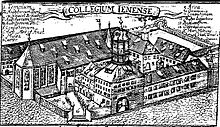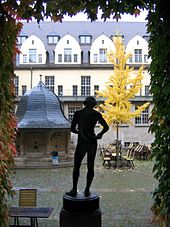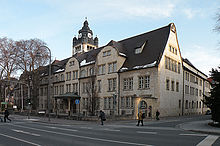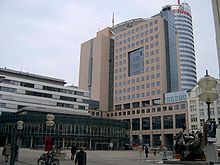University of Jena
Friedrich-Schiller-Universität Jena | |
 | |
| Latin:Universitas Litterarum Jenensis | |
| Type | Public |
|---|---|
| Established | February 2, 1558 |
| Budget | € 372 million[1] |
| President | Walter Rosenthal |
Academic staff | 3,415[2] |
Administrative staff | 5,151[2] |
| Students | 18,219[3] |
| Location | ,, 50°55′42″N11°34′56″E/ 50.92833°N 11.58222°E |
| Campus | University town |
| Affiliations | Coimbra Group EUA |
| Website | uni-jena.de |
TheUniversity of Jena,officially theFriedrich Schiller University Jena(German:Friedrich-Schiller-Universität Jena,abbreviatedFSU,shortened formUni Jena), is apublicresearch universitylocated inJena,Thuringia,Germany.
The university was established in 1558 and is counted amongthe ten oldest universities in Germany.It is affiliated with six Nobel Prize winners, most recently in 2000 when Jena graduateHerbert Kroemerwon the Nobel Prize for physics. It was renamed after the poetFriedrich Schillerwho was teaching as professor of philosophy when Jena attracted some of the most influential minds at the turn of the 19th century. WithKarl Leonhard Reinhold,Johann Gottlieb Fichte,G. W. F. Hegel,F. W. J. SchellingandFriedrich Schlegelon its teaching staff, the university was at the centre of the emergence ofGerman idealismandearly Romanticism.
As of 2014[update],the university has around 19,000 students enrolled and 375 professors. Its current president,Walter Rosenthal,has held the role since 2014.
History
[edit]
Early history
[edit]ElectorJohn Frederick of Saxonyfirst thought of a plan to establish a university atJenaupon Saale in 1547 while he was being held captive by emperorCharles V.The plan was put into motion by his three sons and, after having obtained a charter from the EmperorFerdinand I,the university was established on 2 February 1558. The university, jointly maintained by theSaxon Duchiesderived from the partitioning of John Frederick's duchy, was thus namedDucal Pan-Saxon University(German:Herzoglich Sächsische Gesamtuniversität) orSalana(after theriver Saale).
Prior to the 20th century, university enrollment peaked in the 18th century. The university's reputation reached its zenith under the auspices of DukeCharles Augustus,Goethe's patron (1787–1806), whenGottlieb Fichte,G. W. F. Hegel,Friedrich Schelling,Friedrich von SchlegelandFriedrich Schillerwere on its teaching staff.

Founded as a home for the new religious opinions of the sixteenth century, it has since been one of the most politically radical universities in Germany. Jena was noted among other German universities at the time for allowing students todueland to have a passion forFreiheit,which were popularly regarded as the necessary characteristics of German student life. The University of Jena has preserved a historical detention room orKarzerwith famous caricatures by Swiss painterMartin Disteli.
In the latter 19th century, the department ofzoologytaughtevolutionary theory,withCarl Gegenbaur,Ernst Haeckeland others publishing detailed theories at the time ofDarwin's"Origin of Species"(1858). The later fame ofErnst Haeckeleclipsed Darwin in someEuropeancountries, as the term "Haeckelism" was more common thanDarwinism.

In 1905, Jena had 1,100 students enrolled and its teaching staff (includingPrivatdozenten) numbered 112. Amongst its numerous auxiliaries then were the library, with 200,000 volumes; the observatory; the meteorological institute; the botanical garden; the seminaries of theology, philology, and education; and the well-equipped clinical, anatomical, and physical institutes.
After the end of the Saxon duchies in 1918, and their merger with further principalities into theFree State of Thuringiain 1920, the university was renamed as theThuringian State University(Thüringische Landesuniversität) in 1921. In 1934 the university was renamed again, receiving its present name ofFriedrich Schiller University.During the 20th century, the cooperation betweenZeisscorporation and the university brought new prosperity and attention to Jena, resulting in a dramatic increase in funding and enrollment.
Nazi period
[edit]During the Third Reich, staunchNazismoved into leading positions at the university. The racial researcher andSS-HauptscharführerKarl Astelwas appointed professor in 1933, bypassing traditional qualifications and process; he later became rector of the university in 1939. Also in 1933, many professors had to leave the university as a consequence of theLaw for the Restoration of the Professional Civil Service.Student fraternities – in particular theBurschenschaften– were dissolved and incorporated into the Nazi student federation. The Nazi student federation enjoyed before the transfer of power and won great support among the student body elections in January 1933, achieving 49.3% of the vote, which represents the second best result. Between the Jena connections and the NS students wide-ranging human and ideological connections were recorded.
When the Alliedair raidsto Jena in February and March struck in 1945, the University Library, the university main building and several clinics in the Bachstraße received total or significant physical damage. Completely destroyed were the Botanical Garden, the psychological and the physiological institute and three chemical Institutes. An important event for the National Socialist period was the investigation of the pediatricianYusuf Ibrahim.A Senate Commission noted the participation of the physician to the "euthanasia" murders of physically or mentally disabled children.
Present
[edit]
In the 20th century the university was promoted through cooperation withCarl Zeiss (company)and thereby enabling it to increase the student population as a mass university. In 1905 the university had 1,100 students and 112 university teachers, so this figure has since been almost twenty-fold. The Friedrich-Schiller University is the only comprehensive university in Thuringia.
Since 1995, there is a university association with theMartin Luther University of Halle-Wittenbergand theUniversity of Leipzig.The aim is firstly to give the students the opportunity to visit with relatively few problems at the partner universities and events in order to broaden the range of subjects and topics. Currently e. g. has joined a cooperation in teaching in the field of bioinformatics. In addition, the cooperation provides the university management the opportunity to share experiences with their regular meetings and initiate common projects. So z. B. went from the successful bid to theGerman Centre for Integrative Biodiversity Research (iDiv)from the university network. The co-operation continues at other levels: for example in a joint mentoring program for female postdocs or in the central German archives network. And last but not least, there are common sports activities.
Since October 2014, the pharmacologistWalter Rosenthalis the president of the university;Chancelloris since 2007 the mathematician Klaus Bartholmé.[4]
Organization
[edit]

The university is organized in 10 schools:
- theology
- jurisprudence
- economicsandbusiness administration
- humanities
- socialandbehavioural sciences
- mathematicsandcomputer science
- physicsandastronomy
- chemicalandearth sciences
- biologyandpharmacy
- medicine
Research
[edit]Research at Friedrich Schiller University traditionally focusses on both humanities and sciences. In addition to the faculties the following "Collaborative Research Centers" (German"Sonderforschungsbereich", short: "SFB" ) operate at the university:
- CRC 1076 AquaDiva: Understanding the Links Between Surface and Subsurface Biogeosphere
- CRC/TR 124 FungiNet: Pathogenic fungi and their human host: Networks of interaction
- CRC 1127 ChemBioSys: Chemical Mediators in Complex Biosystems
- CRC/TR 166 ReceptorLight: High-end light microscopy elucidates membrane receptor function
- CRC 1278 Polymer-basednanoparticlelibraries for targeted anti-inflammatory strategiesde
- CRC / TR 234 CataLIGHT: Light-driven Molecular Catalysts in Hierarchically Structured Materials – Synthesis and Mechanistic Studiesde
- CRC 1375 NOA: Nonlinear Optics down to Atomic Scales
Participations in DFG-Collaborative Research Centres:
- CRC 950 Manuskriptkulturen in Asien, Afrika und Europa
- CRC/TRR 212 A Novel Synthesis of Individualisation across Behaviour, Ecology and Evolution: Niche Choice, Niche Conformance, Niche Construction
In 2006 the research center, Jena Center – History of the 20th century, was founded. In 2007 the graduate school "Jena School for Microbial Communication" (JSMC) was established within theGerman Universities Excellence Initiative.In 2008 the Center for Molecular Biomedicine (CMB) and the interdisciplinary research center Laboratory of the Enlightenment were developed as research institutions. 2014 the "Center of Advanced Research" (ZAF) was established.
Jena University is one of the founder of The German Centre for Integrative Biodiversity Research (iDiv) Halle-Jena-Leipzig, that was founded in 2013. It is a research centre of the German Research Foundation (DFG).
Friedrich Schiller University is the only German university with chairs for eithergravitational theoryor Caucasus Studies.
Rankings
[edit]| University rankings | ||||||||||
|---|---|---|---|---|---|---|---|---|---|---|
| Overall – Global & National | ||||||||||
| ||||||||||
The University of Jena is recognized in severaluniversity rankingsystems. As per theQS World University Rankingsfor 2024, the university is ranked 461st in the world and 26th nationally.[5]In theTimes Higher Education World University Rankingsof 2024, it is placed at 201-250th globally and 22-24th within the country.[6]TheAcademic Ranking of World Universities(ARWU) for 2022 places it within the 401-500 bracket globally, and between 25th and 31st in the national context.[7]
Notable faculty and alumni
[edit]- Manuk AbeghianArmenianphilologist and linguist
- Eva Ahnert-Rohlfs(doctorateinastronomy1951)
- Wilibald Artus(1811–80), Professor of Philosophy
- Johann Bachstrom,writer, scientist,physicianandLutherantheologian
- Ernst Gottfried Baldinger,German physician
- Hans Berger
- Otto Binswanger
- Albrecht von Blumenthaltaught Classical Philology asPrivatdozent1922–8
- Rudolf Brandt(1909–48), Nazi SS officer, executed for war crimes
- Werner Braune(1909–51), Nazi SS officer, executed for war crimes
- Alfred Brehm
- Clemens Brentano
- Rudolf Carnap
- Heinrich Cotta,pioneer of scientific forestry
- Georg Friedrich Creuzer
- Claus Dierksmeier,German philosopher
- Carl H. Dorner
- Ernst Christoph Dressler(1734–79), German composer, operatic tenor, violinist and music theorist
- Rudolf Christoph Eucken
- Johann Gottlieb Fichte
- Gottlob Frege
- Roland Freisler
- Michael Fritsch
- Johann Matthias Gesner
- Nelson Glueck
- Peter Griess
- Friedrich von Hagedorn
- Arvid Harnack
- Karl Hase
- Gerhart HauptmannNobel Prize-winning writer
- Georg Wilhelm Friedrich Hegel
- Cuno Hoffmeister
- Katja Hoyer
- Maximilian von Jaunez(1873–1947), industrialist and politician
- Thede Kahl
- George Kessler
- Georg Klaus
- Christian Knaut,17th Century botanist after whomKnautia arvensiswas named by Linnaeus
- Karl Korschgraduated from the University of Jena's law school summa cum laude superato, 1911
- Jan Kollár,Panslavist and poet
- Li Linsi,Chinese educator and diplomat
- István Kováts
- Karl Christian Friedrich Krause
- Herbert Kroemer,Nobel Prize–winning physicist
- August Leskien
- Robert Ley
- Francis Lieber,emigrant to USA, author of "Lieber Code"
- Georg Limnaeus(Magisters der Philosophie, 1581) astronomer, mathematician, natural philosopher, corresponded with Kepler and Galileo
- Margaret Schönberger Mahler(Medicine, 1922) Austrian pediatrician, psychiatrist, and psychoanalyst
- Lucas Maius
- Karl Marx(doctoratein absentia,1841)
- Johann Jakob Müller,German moral philosopher
- Ernest Nash
- Novalis
- Ernst Ottwalt
- Axel Oxenstierna
- Henri Pittier
- Samuel von Pufendorf
- Gerhard von Rad
- Werner Rolfinck
- Erich Roth(1910–47), Nazi Gestapo member executed for war crimes
- Solomon Marcus Schiller-Szinessy,doctorate (Philosophy,Mathematics)
- Friedrich Wilhelm Joseph Schelling
- Katja Schenke-Layland
- Friedrich Schiller
- August Wilhelm Schlegel
- August Schleicher,German Linguist,Tree model
- Matthias Schleiden,German Botanist
- Arthur Schopenhauer(philosophy doctoratein absentia,1813)
- Otto Schott,inventor of borosilicate glass
- Hugo Schuchardt,linguist
- David Spence (rubber chemistry),early pioneer in rubber chemistry
- Johann Gustav Stickel,orientalist
- Michael Stifel,monk and mathematician
- Cajetan Tschink,writer and philosopher
- Kurt Tucholsky,journalist and satirist
- Erhard Weigel,mathematician, astronomer, and philosopher
- Christa Wolf,novelist and essayist
- Christian Wolff,philosopher
- Carl Zeiss,optician
Museums and collections at the University
[edit]Among the collections which are open to the public are theJena Phyletisches Museum,an institution which is unique in Europe for illustrating the history of evolution, the Ernst-Haeckel-Memorialmuseum, the Mineralogical Collection which traces its roots back to Goethe and the second oldestBotanical GardenofMiddle Europe.TheSchiller Gardenhouse(Schillers Gartenhaus) and the Goethe Memorial at the Botanical Garden are reminders of the two towering geniuses of Jena. Both buildings are also open to the public.
Oriental Collections / Papyrus Collection
- The Alphons-Stübel-Collection of Early Photographs from the Orient (1857–1890)
- Hilprecht Collection
- Orientalisches Münzkabinett (OMJ)
- Papyrus Collection
Archaeological Collections
- Collection of Ancient Art
- Collection of Plaster Casts of Ancient Sculpture
- The Photo- and Slide Collection of the Institute of Classical Archaeology
- The Collection of Prehistory and Early History
- The Bilzingsleben collection
- Departement of Art History and Custodia
Natural Sciences and Natural History
- The Ernst-Haeckel-Haus
- Zygomycetes (Mould Fungi)
- Didactics of Biology
- Herbarium Haussknecht (JE)
- Botanical garden
- Phyletic Museum
Mineralogy & Geology
- Mineralogical Collection
- Teaching Collection of Models for Mineralogy
History of Sciences
- Collection of scientific and technical devices for physics
- Astronomical collection
Medicine
- The Meyer Steineg Collection of Medical History in Jena
- Anatomical Collection
- Medical History
- Goethe Memorial
See also
[edit]- List of early modern universities in Europe
- The Collection of Pre- and Protohistoric Artifacts at the University of Jena
Notes
[edit]This article includes a list of generalreferences,butit lacks sufficient correspondinginline citations.(May 2015) |
- ^"Budget and Infrastructure".University of Jena.Archived fromthe originalon 21 April 2017.Retrieved20 April2017.
- ^ab"Staff".University of Jena.Archived fromthe originalon 17 December 2017.Retrieved20 April2017.
- ^"Student Statistics".University of Jena.Archived fromthe originalon 9 November 2017.Retrieved20 April2017.
- ^Klaus Bartholmé (FSU)
- ^ab"QS World University Rankings 2024".QS World University Rankings.Retrieved16 July2023.
- ^ab"World University Rankings 2024".Times Higher Education World University Rankings.27 September 2023.Retrieved27 September2023.
- ^ab"2023 Academic Ranking of World Universities".Academic Ranking of World Universities.Retrieved15 August2023.
References
[edit]- This article incorporates text from a publication now in thepublic domain:Chisholm, Hugh,ed. (1911). "Jena".Encyclopædia Britannica.Vol. 15 (11th ed.). Cambridge University Press. p. 315.
Literature
[edit]- Mayhew, Henry (1864): German Life and Manners as Seen in Saxony at the Present Day: With an Account of Village Life – Town Life – Fashionable Life – Domestic Life – Married Life – School and University Life, &c., of Germany at the Present Time: Illustrated with Songs and Pictures of the Student Customs at the University of Jena. In Two Volumes. London [Vol. II, Section VII, Chapter VI-XI: Student Life at Jena].
External links
[edit]- Official website.Archived6 October 2016 at theWayback Machine.
- University of Jena, statistics.Archived29 July 2016 at theWayback Machine(in German).
- Norbert Nail: Der schottische DichterCharles Hamilton Sorleyals Student im Sommer 1914 an Saale, Lahn und Mosel[1](in German)
- Norbert Nail:John Baillie– Schotte, Pastor, Student 1909/11 in Jena und Marburg. In: Studenten-Kurier 3/2017, pp. 16–18.[2](in German)
- Norbert Nail: Ein tödliches Pistolenduell 1848 auf der Trießnitz in (Jena-)Winzerla. In: Studenten-Kurier 1–2/2019, pp. 12–17[3](in German – a deadly student duel at Jena)
